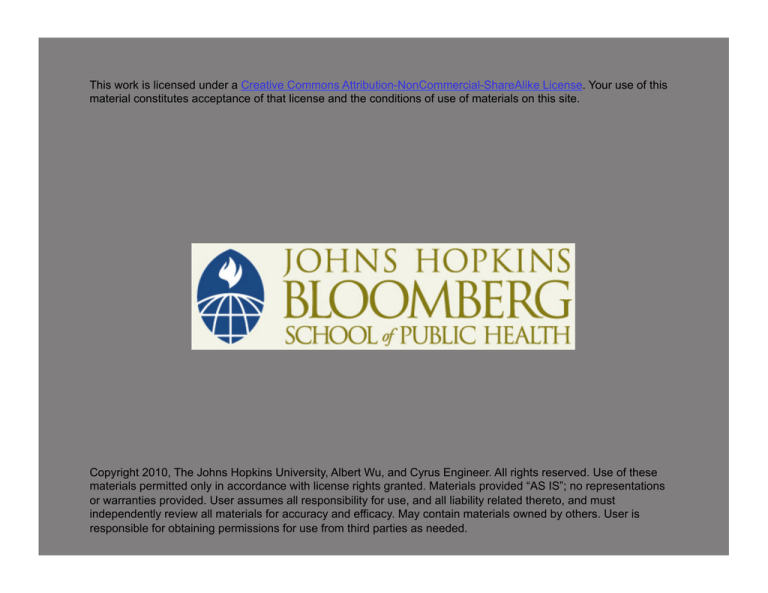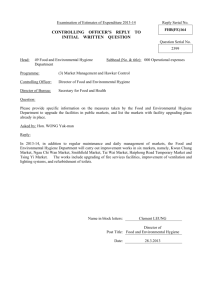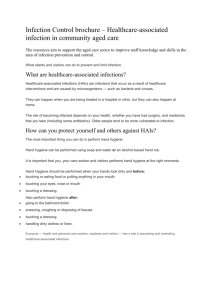
This work is licensed under a Creative Commons Attribution-NonCommercial-ShareAlike License. Your use of this
material constitutes acceptance of that license and the conditions of use of materials on this site.
Copyright 2010, The Johns Hopkins University, Albert Wu, and Cyrus Engineer. All rights reserved. Use of these
materials permitted only in accordance with license rights granted. Materials provided “AS IS”; no representations
or warranties provided. User assumes all responsibility for use, and all liability related thereto, and must
independently review all materials for accuracy and efficacy. May contain materials owned by others. User is
responsible for obtaining permissions for use from third parties as needed.
Clean Care Is Safer Care and the WHO Guidelines
on Hand Hygiene in Health Care
Cyrus Engineer, DrPH, MHA, MHS
Albert Wu, MD, MPH
Johns Hopkins University
Section A
Burden of Health Care–Associated Infections (HAI) and
Importance of Hand Hygiene
The Big Picture
Huge global burden of health care–associated infections
One in 10 hospital admits results in HAI
Approximately 770 million admissions globally each year
72 million patients affected by HAI
Death rate due to HAI (~3.0%)
Among top three killers
4
Health Care–Associated Infection (HAI)
1.4 million people worldwide affected at any given time
5% to 10% of hospital patients in developed countries
Two to 20 times higher HAI risk in developing countries
In some countries 25% of patients are affected
In the UK there are 100,000 case of HAI per year and 5,000 deaths
5
Costs of Common HAIs
Attributable costs in U.S. Dollars
Range
HCAI type
Mean
SD
Minimum
Maximum
Bloodstream
infection
36,441
37,078
1,822
107,156
Surgical site
infection
25,546
39,875
1,783
134,602
Ventilatorassociated
pneumonia
9,969
2,920
7,904
12,034
Urinary tract
infection
1,006
503
650
1,361
Source: Bennett.
6
First Global Patient Safety Challenge
To reduce health care–associated infections worldwide
Image source: WHO
7
Launch of the First Global Patient Safety Challenge
WHO HQ, October 13, 2005
Image source: WHO
8
The First Global Patient Safety Challenge
Five integrated action areas
Clean blood
Clean equipment
Clean hands
Clean water
Image source: WHO
Clean procedures
9
Hand Hygiene Is the Entrance Door …
To safer
patient
care
To safer
patient care
10
Ignaz Philipp Semmelweis
The pioneer of hand hygiene
Austria
General Hospital of Vienna,
1841–1850
Fighting puerperal fever
11
Studies Showing Effectiveness of Hand Hygiene
From 1975 to 2005, 17 studies demonstrated the effectiveness of
hand hygiene promotion to reduce health care-associated
infections—the most relevant are listed in the table below
Year
2000
2004
Authors
Pittet et al.
Won et al.
Hospital
setting
Significant results
Hospitalwide
Significant (p=0.04 and p<0.001) reduction in
the annual overall prevalence of health care–
associated infections (41.5%) and MRSA crosstransmission rates (87%)
5 years
NICU
Significant (p=0.003) reduction in health care–
associated infection rates (from 15.1/1000
patient-days to 10.7/1000 patient-days), in
particular of respiratory infections
2 years
21 months
36 months
2005
Rosenthal et
al.
Adult ICUs
Significant (p<0.0001) reduction in health
care–associated infection rates (from
47.5/1000 patient-days to 27.9/1000 patientdays)
2005
Johnson
et al.
Hospitalwide
Significant (p=0.01) reduction (57%) in MRSA
bacteremia
Source: Adapted from Pittet, D., et al. (2006). Lancet Infectious Diseases.
Duration of
follow-up
12
Bottom Line
Strong evidence between improved adherence of hand hygiene
practice and reduction in health care–associated infection rates
Hand hygiene is the single most effective intervention to reduce
HAIs—reduction seen from 30% to 50%
Either hand washing or hand rubbing reduces HAIs
Scientific basis/models for hand transmission well established
Tools and training material available
13
The Magnitude
Reported hand hygiene compliance within different hospitals
Author
Year
Sector
Compliance
Preston
1981
General wards
ICU
16%
30%
Albert
1981
ICU
ICU
41%
28%
Larson
1983
Hospital-wide
45%
Donowitz
1987
Neonatal ICU
30%
Graham
1990
ICU
32%
Dubbert
1990
ICU
81%
Pettinger
1991
Surgical ICU
51%
Larson
1992
Neonatal unit
29%
Doebbeling
1992
ICU
40%
Zimakoff
1993
ICU
40%
Meengs
1994
Emergency room
32%
Pittet
1999
Hospital-wide
48%
<40%
Source: Pittet and Boyce. (2001). Lancet Infectious Diseases.
14
Question?
Hand hygiene: Why is something that is seemingly so simple to
perform so complex?
Why is it so hard to get health care workers to wash/rub their hands
despite the hard evidence?
15
Section B
Reasons for Non-compliance and the WHO Multi-modal
Hand Hygiene Strategy
First Global Patient Safety Challenge
To reduce health care–associated infections worldwide
Image source: WHO
17
Designing More Efficient Intervention Strategies
Understanding the key determinants underlying a given behavior in
a specific situation: one of the first steps to design more efficient
public health intervention strategies
To identify the factors that define an individual’s behavioral
intention
18
Hand Hygiene (HH)
Main reasons for poor compliance
Reported
Observed
1. Skin irritation by HH agents
X
X
2. Inaccessible HH supplies
X
(X)
3. Interference with HCW-patient relation
X
?
4. Patient needs take priority
X
?
5. Wearing of gloves
X
X
6. Not thinking about it/forgetfulness
X
(X)
7. Lack of knowledge of guidelines
X
X
Source: Pittet and Boyce. (2001, April). Lancet Infectious Diseases.
19
Relevant Obstacles in Some Settings
Lack of facilities (sinks) and of continuous access to clean water,
soap, and paper towels
Image source: WHO
20
Hand Hygiene (HH)
Main reasons for poor compliance
Reported
Observed
1. Skin irritation by HH agents
X
X
2. Inaccessible HH supplies
X
(X)
3. Interference with HCW-patient relation
X
?
4. Patient needs take priority
X
?
5. Wearing of gloves
X
X
6. Not thinking about it/forgetfulness
X
(X)
7. Lack of knowledge of guidelines
X
X
Source: Pittet and Boyce. (2001, April). Lancet Infectious Diseases.
21
Overcoming the Time Constraint Obstacle
Handrubbing with alcohol-based solutions to overcome the time
constraint obstacle
-
-
Handwashing – 1 to 1.5 minutes
Alcohol-based handrubbing – 15 to 20 seconds
22
Maternal Mortality Before and After Intervention
23
Compliance by Professional Category
24
Compliance Levels across Hospital Units
25
Compliance and Opportunities for HH
26
Non-compliance with Hand Hygiene, HUG 1994
•
•
Time constraint is the main explanatory factor
When the number of opportunities is greater than 10 per hour, compliance decreases
on average by 5% (+2%) per 10 opportunities per hour of care
27
Application Time of HH and Reduction in Bacteria
28
The WHO Multimodal HH Implementation Strategy
An evidence-based
approach made up of five
core components to
improve hand hygiene in
health care settings
System change
Alcohol-based handrubs at point of care and
access to safe continuous water supply, soap, and towels
+
Training and education of staff
+
Observation of hand hygiene and
feedback to staff
+
Reminders in the workplace (posters)
+
Establishment of a safety climate
Individual active participation and institutional support
29
Pilot Implementation Pack
30
Guide to Local Production
31
Local Production: Alcohol-Based Handrubs?
Image source: WHO
32
Hong Kong 2007
41 public hospitals: 18,150
gallons per month
More than 5 million x 100 ml
bottles annually
- Economies of scale—
approximately $4 HK a
bottle (50 cents U.S., 25
pence)
Image source: WHO
33
Easy Infection Control for Everyone …
Image source: WHO
34
Cost Comparison
31.8 million Euros
X 100
0.312 million Euros
Costs of NI
Costs of hand hygiene
Average infection rate, 1999–2001: 9.7 per 100 admissions
Estimates in Euros: 31.8 million from nosocomial infections
Total costs in Euros: 0.312 million for hand hygiene promotion
35
Cost Comparison
The total costs of the campaign
averaged 2.53 Euros per admission in
2001
It corresponded to approximately 1%
of costs attributable to nosocomial
infections
36
Expanding the Multimodal Strategy
Expanding the multimodal strategy to a hand hygiene national
campaign
116 hospitals
25% increase of hand hygiene
compliance in four months
17,000 infections prevented in 2006
Cost savings: 60 million CHF in 2006
37
Easy Infection Control for Everyone …
Simple measures save lives!
It is now possible to improve hand
hygiene in your facility! It’s your
duty, to protect patients and
yourself! You can make a change!
Image source: WHO
38
The WHO Guidelines on HH in Health Care (Advanced Draft)
Two international
consultations
Nine task forces
Over 100 international
experts
Over 700 references
Testing of the implementation
strategy
Translation into WHO official
languages
39
Save Lives: Clean Your Hands Initiative
Next logical step is to move toward “point of care”
Endorsement from over 5,700 health care facilities from 122 countries
Tools and guidelines freely made available
-
-
-
-
-
Tools for system change
Tools for training and education
Tools for evaluation and feedback
Tools for assessing institutional safety climate
Tools as reminders in the work place
For further information, please visit the Web site
- http://www.who.int/gpsc/en/
Any facility can access the WHO guidelines and a suite of tools from the
Web site
40






